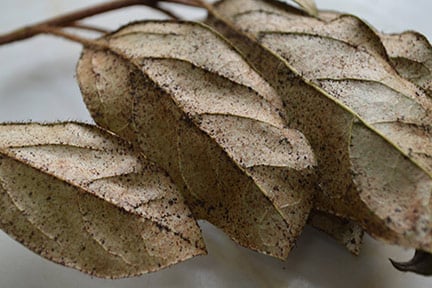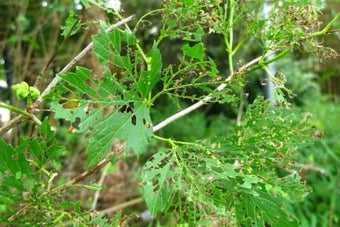
Quick facts
Common name - Glasshouse thrips
Scientific name - Heliothrips haemorrhoidalis
Plants affected - Many glasshouse vegetables and ornamental plants. Outdoor plants, particularly Viburnum tinus hedges can also be affected
Main symptoms - Silvery mottling and brown marks
Most active - April to September but all year round in glasshouses
What are glasshouse thrips?
Thrips (also known as thunder flies) are an order of insects, the Thysanoptera. Around 150 species are found in Britain. These species are small (1-2 mm long) elongate insects. Whilst many feed by sucking from leaves and flowers most do not cause noticeable damage to host plants. A few species can however cause mottling to some plants and spread plant viruses.
Glasshouse thrips adults have narrow dark brown bodies up to 2 mm in length with an orange tipped abdomen. They have pale yellow antennae, legs and wings which are fringed with short hairs and folded back over the abdomen whilst at rest. Several other species of thrips may be encountered in gardens.
Symptoms
The feeding activities of glasshouse thrips cause a fine pale mottling of the upper leaf surfaces and affected foliage usually develops a silvery colouration. The foliage is also marked with small red-brown spots caused by the thrips excrement. When feeding occurs on developing shoot tips or flower it can cause distorted growth.
Since 2010 glasshouse thrips has become common out of doors on evergreen shrubs in parts of southern England, viburnums and some other evergreen shrubs are often affected.

Management
If you encounter this insect on indoor plants then please consult our page on indoor plants: sap feeders for indoor specific advice.
- Tolerate some thrips damage, despite extensive silvery mottling established outdoor shrubs will usually survive the presence of this insect
- Encourage natural enemies in gardens, for example the predatory bug Orius laevigatus can occur naturally
- Biological controls are available for use in glasshouses. These include a predatory bug (Orius laevigatus) and mites (Amblyseius species, Hypoaspis species and Macrocheles roibustulus (sold as Mighty Mite)). There is also a nematode biological control sold as Fruit and Vegetable Protection’. The nematodes can potentially affect other insects and the predators can feed on invertebrates other than thrips. These can be purchased from biological control suppliers (downloads pdf document)
- Hanging blue sticky traps (widely available from garden suppliers) above or among the plants in glasshouses can trap thrips and help monitor and reduce numbers. This is not recommended out of doors as the traps will capture a large number of non-target invertebrates
Downloads
Biological control suppliers (pdf document)
Biology
Adult glasshouse thrips can lay up to 100 eggs at a rate of one or two per day. These are often deposited on the younger leaves or in flower of host plants.
The immature stages (nymphs), are yellow-brown and have three stages of development. The first two stages, like the adults, feed by sucking and are entirely wingless. ‘Wing buds’ develop on the third stage which does not feed and is known as a pre-pupal stage. The pre-pupal and pupal stages take place in the soil and in sheltered places on the host plant. Wings are not fully formed until the adult thrips emerge.
The length of the life cycle varies and is affected by temperature. Under warm conditions the life cycle is completed in 24-35 days and glasshouse thrips can breed throughout the year.









